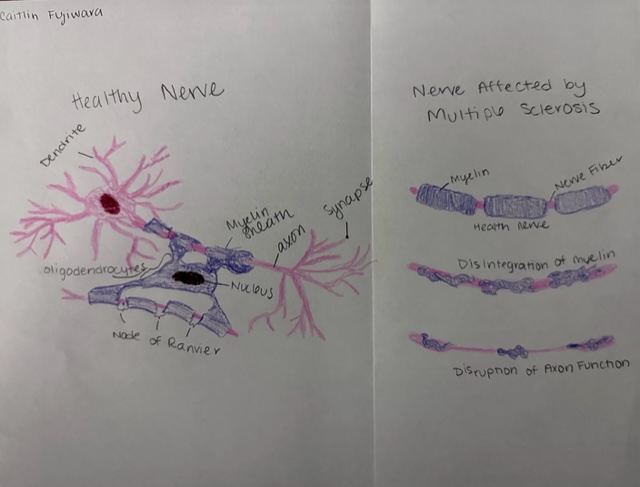Multiple Sclerosis: Effects on Sensory Nerves
Close to one million individuals in the United States live with the autoimmune neurodegenerative disease, multiple sclerosis. Multiple sclerosis (MS) is a chronic inflammatory disease that affects the nerves within the central nerve system. These nerves can be found in the brain and the spinal cord. MS damages the myelin sheaths permanently that are wrapped around the axon of the nerve. This essay aims to discuss components and key structures of a neuron and how MS damages these structures.
Within the brain and spinal cord there are numerous types of nerves. There are nerves of the peripheral nervous system and the central nervous system. Typically, the structure of a nerve includes a cell body. This houses the nucleus, and dendrites that are the receptive regions. There is an axon, like a tail, which has many myelin sheaths wraps which are comprised of Schwann cells spaced out with gaps called nodes of Ranvier (Christogianni, et al., 2018). At the end of the axon there is an axon terminal projection that is the secretory region of the nerve.
Since multiple sclerosis attacks the axons of nerves within the central nervous system it is important to know there is a slight difference in the CNS nerve cells myelination. The myelin sheaths in the central nervous system are formed by oligodendrocytes. These cells can wrap around sixty axons at once. The white matter of the brain there are these dense collections of the myelinated neurons (Christogianni, et al., 2018). Within the gray matter of the brain, there are neuron cells bodies. These are mostly nonmyelinated fibers, meaning they are fibers without myelin protection (Eshaghi, et al, 2018).
These myelin sheaths help communication between each nerve quickly and smoothly. Multiple sclerosis causes damage or complete destruction of these sheaths. And in more advanced MS, there is damage to the nerve axon. The bodies T-cells attack the myelin sheath leading to this destruction (van Langelaar, et al, 2020). This damage leads to the signals between nerves to be compromised which leads to numbness, mood changes, memory problems, fatigue, and more (Mross, et al., 2022). Further studies show that it is damage to the nerve axon that leads to the increase in symptoms. When the axon is damaged perforin a mediator in cell cytotoxicity and apoptosis was released and caused cell death (Lemus, Warrington, & Rodriguez, 2018).
The cause of MS is still unknown. There are risks to developing MS such as genetics (a family history of MS), gender (females have a higher change of development), low vitamin D levels (individuals living at higher latitudes which cause a lack of sunlight), Epstein-barr virus infection, and links showing low socioeconomic status can increase MS development (Doshi & Chataway, 2016). Currently there is no cure to prevent MS nor is there any way to treat or regrow these myelin sheaths. There are treatments to help with relapse management, treatment of symptoms, and treatment to help modify progression (Doshi & Chataway, 2016). Although there is no cure, individuals living with MS can have a fulfilled long life with disease management.

Resources:
Christogianni, A., Bibb, R., Davis, S., Jay, O., Barnett, M., Evangelou, N., & Filingeri, D. (2018). Temperature sensitivity in multiple sclerosis: An overview of its impact on sensory and cognitive symptoms. Temperature (Austin, Tex.), 5(3), 208-223. Retrieved from https://doi.org/10.1080/23328940.2018.1475831
Doshi, A., & Chataway, J. (2016). Multiple sclerosis, a treatable disease. Clinical medicine, 16(6), 53-59. Retrieved from https://doi.org/10.7861/clinmedicine.16-6-s53
Eshaghi, A., Marinescu, R. V., Young, A. L., Firth, N. C., Prados, F., Jorge Cardoso, M., Tur, C., De Angelis, F., Cawley, N., Brownlee, W. J., De Stefano, N., Laura Stromillo, M., Battaglini, M., Ruggieri, S., Gasperini, C., Filippi, M., Rocca, M. A., Rovira, A., Sastre-Garriga, J., Geurts, J. J. G., … Ciccarelli, O. (2018). Progression of regional grey matter atrophy in multiple sclerosis. Brain: a journal of neurology, 141(6), 1665–1677. https://doi.org/10.1093/brain/awy088
Lemus, H. N., Warrington, A., & Rodriguez, M. (2018). Mechanisms of Disease and Strategies for Myelin and Axonal Repair. Neurologic clinics, 36(1), 1-11. Retrieved from https://doi.org/10.1016/j.ncl.2017.08.002
Mross, K., Jankowska, M., Meller, A., Machowska-Sempruch, K., Nowacki, P., Masztalewicz, M., & Pawlukowska, W. (2022). Sensory Integration Disorders in Patients with Multiple Sclerosis. Journal of clinical medicine, 11(17), 5183. Retrieved from https://doi.org/10.3390/jcm11175183
van Langelaar, J., Rijvers, L., Smolders, J., & van Luijn, M. M. (2020). B and T Cells Driving Multiple Sclerosis: Identity, Mechanisms and Potential Triggers. Frontiers in immunology, 11, 760. https://doi.org/10.3389/fimmu.2020.00760

Caitilin Fujiwara’s STEAM project is Multiple Sclerosis: Effects on Sensory Nerves she explains in her project about multiple sclerosis and the steps and the effect on the sensory nerves. She explains that there are multiple types of nerves within the brain and spinal cord. The PNS or peripheral nervous system and CNS central nervous system. Multiple sclerosis is a type of chronic disease, and it affects the nerves within the CNS. I have learned that this neurodegenerative autoimmune disease attacks the axons at the central nervous system or CNS and it can damage or it could completely destroy the myeline sheath in the axon as multi sclerosis attacks it. This will damage the signal between nerves that will lead to numbness, mood change, memory problem, and fatigue. It is a scary nerve disease as the cause is still unknown even with our modern science today. This project shows the risks factors and the people that are high at risk of getting the disease, like my STEAM project osteoporosis, osteopenia, and normal bone I put there that women are more susceptible to those bone diseases apparently even in MS women has higher chance of having it and people that as low in vitamin D, which is vital for our bone too. With her art I can see that she draw the structure of a motor neuron and a nerve that is affected by MS I would say that she had drew the cell body and the other parts of the nerve just about right.